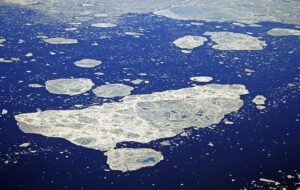After three years of ongoing research by an international team of scientists, a study commissioned by the Arctic Monitoring and Assessment Programme for a first-ever comprehensive assessment of Arctic Ocean acidification was presented last week at a meeting of Arctic Council Ministers in Bergen, Norway.
Arctic Ocean Acidification Facts
 The research show that the cold waters of the Arctic sea are more vulnerable to acidification. Cold water more readily absorbs CO2 and combined with the precipitous drop in summer sea ice extent, thus exposing more open water, northern oceans are rapidly acidifying.
The research show that the cold waters of the Arctic sea are more vulnerable to acidification. Cold water more readily absorbs CO2 and combined with the precipitous drop in summer sea ice extent, thus exposing more open water, northern oceans are rapidly acidifying.
“The sea ice has been a lid on the Arctic, so the loss of ice is allowing fast uptake of CO2,” said Richard Bellerby of the Norwegian Institute for Water Research, chairman of the report.
Freshwater flows exacerbating arctic ocean acidification
Ocean waters in the north are made even more vulnerable to acidification by increased freshwater flows from rivers and melting land ice. Freshwater is less able to neutralize the acidifying effects of CO2, Bellerby explains.
“Large rivers flow into the Arctic, which has an enormous catchment for its size,” he said. “There’s slow mixing so in effect we get a sort of freshwater lens on the top of the sea in some places, and freshwater lowers the concentration of ions that buffers pH change.”
Threshold passed, habitats threatened
Even given the fantasy of immediate and aggressive efforts to mitigate carbon emissions, increased ocean acidification in the Arctic (and globally) is already baked into the climatic system
“We have already passed critical thresholds. Even if we stop emissions now, acidification will last tens of thousands of years. It is a very big experiment,” says Bellerby.
Other conclusions of the study show probable impacts on ecosystems and habitats throughout the Arctic from ocean acidification – among these findings:
- Due to the relatively simple food webs found in the Arctic, ecosystems are more vulnerable to changes when key species are impacted by external factors (such as acidification)
- Ocean acidification is likely to directly or indirectly affect Arctic marine organisms throughout the food chain, from plankton to fish
- What impacts marine organisms impacts humans as well. Arctic ocean acidification will have potentially adverse effects on commercial fisheries and marine resources used and relied upon by indigenous people
Image credit: banyaman, courtesy flickr
Featured image credit: NASA’s Marshall Space Flight Center, courtesy flickr



People of the world have done this. I have done the impossible by ending carbon dioxide from going into the environment by stopping it cold in tracks and storing it very safely. I can do this everywhere and any where on this planet. If we make it, it can be destroy to clean up the air. The planet has about 50-100 ppm of carbon dioxide to keep it healthy and wholesome. What do we do now we up to 400 ppm. Everything is becoming with very in acidity in our waters and our oceans. People are dying from all of this and the government does not know I can change this all around the world. Look at my website and everything else to find the answers and how we can help.